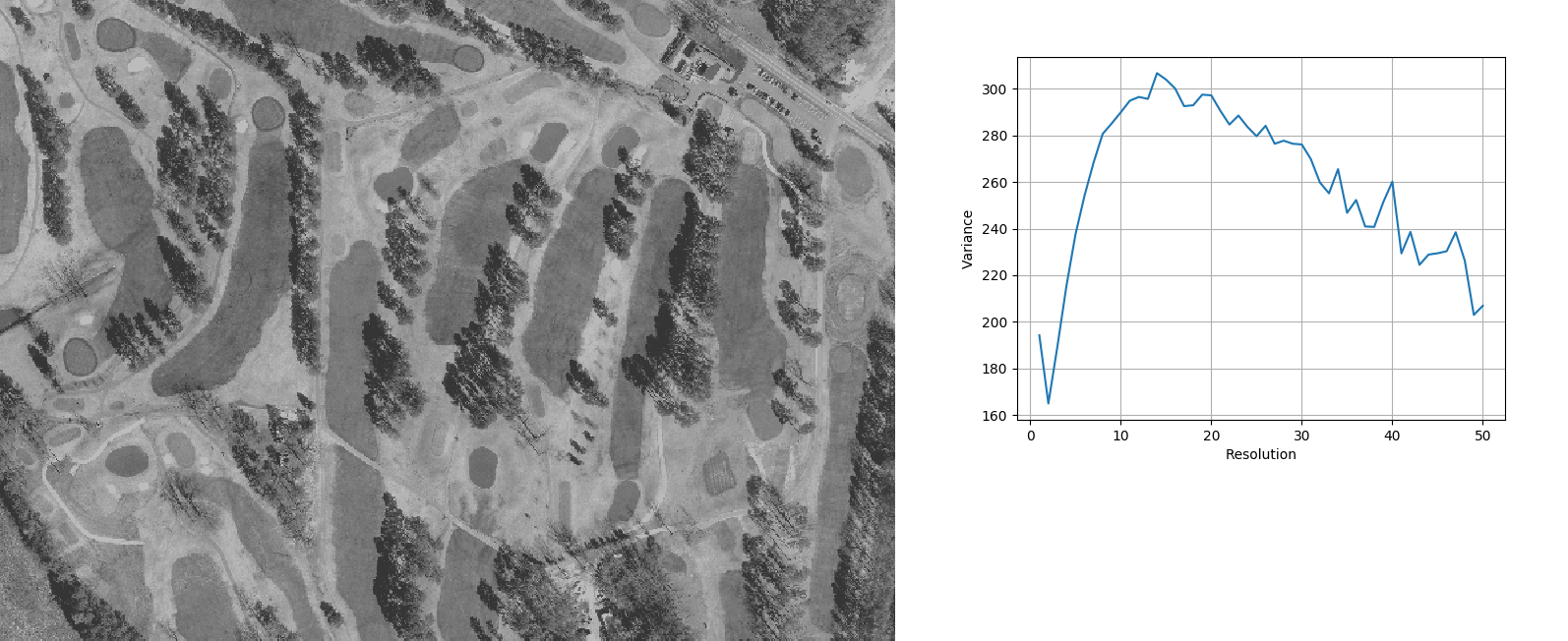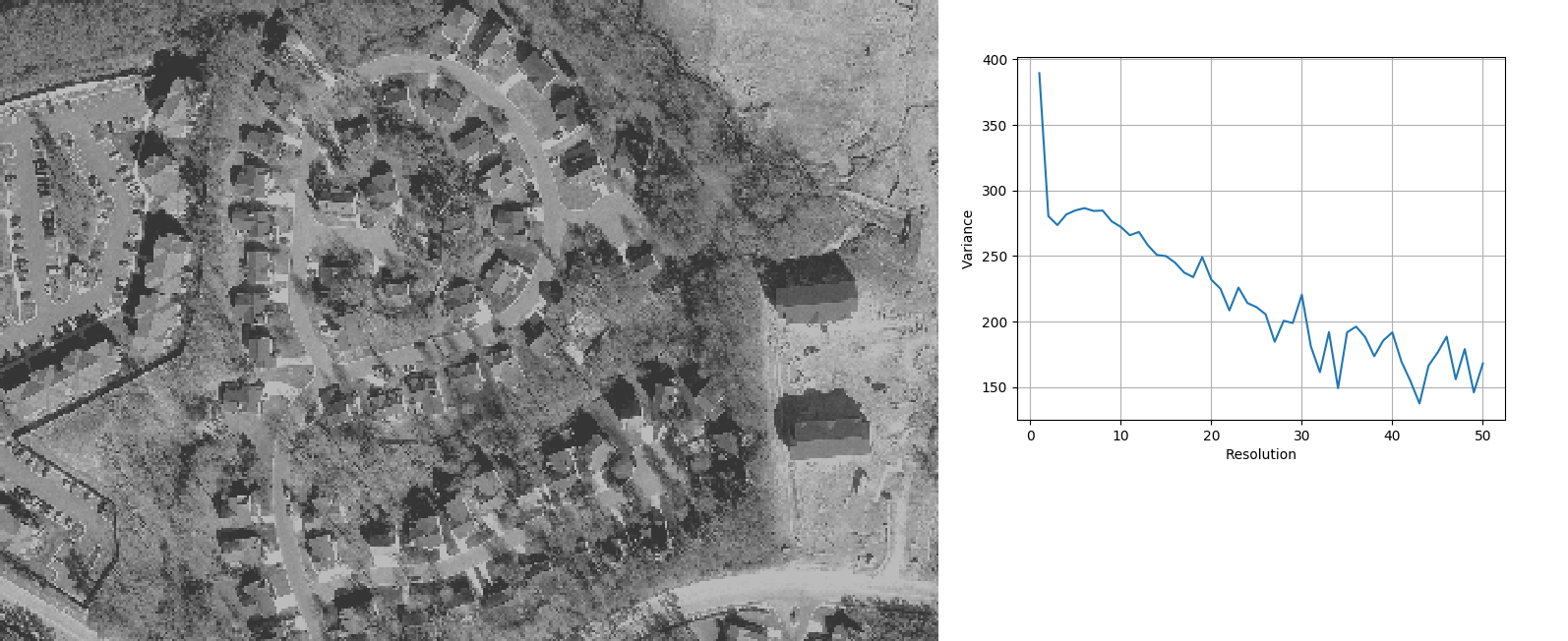
NAME
i.variance - Analyses variation of variance with variation of resolutionKEYWORDS
imagery, variance, resolutionSYNOPSIS
Flags:
- --overwrite
- Allow output files to overwrite existing files
- --help
- Print usage summary
- --verbose
- Verbose module output
- --quiet
- Quiet module output
- --ui
- Force launching GUI dialog
Parameters:
- input=name [required]
- Raster band on which to perform analysis of variation of variance
- csv_output=name
- Name for output file
- Name for output file
- plot_output=name
- Name for graphic output file for plot (extension decides format, - for screen)
- Name for output file
- min_cells=integer
- Minimum number of cells at which to stop
- max_size=float
- Maximum pixel size (= minimum resolution) to analyse
- step=float [required]
- Step of resolution variation
- Default: 1
Table of contents
DESCRIPTION
Following the Woodcock and Strahler (1987), i.variance resamples a raster input layer (normally a remotely sensed image) to successively decreasing resolutions and calculates the mean local variance of the entire image at each resolution. Local variance is defined as the variance in a 3x3 window.
The modules starts at the current computing region resolution and then decreases the resolution (increases the pixel size) by step until it reaches the maximum size of pixels (aka minimum resolution) determined by the max_size parameter, or when the number of total pixels falls below min_cells. If both are given, min_cells takes precedence.
Resampling to lower resolution uses the average of higher resolution pixels.
By default, the module prints a comma separated list to stdout containing each resolution that represents a local maximum of variance (higher variance than the resolution before and after in the iterations) as well as the difference in variance with the neighbor with most similar variance.
In addition, the user can choose to output the results in the form of a graph plotting variance against resolution (plot_output) either to a file by giving a file name (its extension determines the output format) or to the screen using '-'. The entire data of variance depending on resolution can also be saved in a csv file using csv_output.
NOTES
The aim of this module is to provide diagnostics to the user about the size of detectable "objects" in an image. This can provide helpful input to modules that take a window size or desired object size as input, such as, for example, r.texture and i.segment.As Woodcock and Strahler (1980) write: "The reasoning behind this measure is as follows. If the spatial resolution is considerably finer than the objects in the scene, most of the measurements in the image will be highly correlated with their neighbors and a measure of local variance will be low. If the objects approximate the size of the resolution cells, then the likelihood of neighbors being similar decreases and the local variance rises. As the size of the resolution cells increase and many objects are found in a single resolution cell, the local variance decreases."
EXAMPLE
The three examples based on the North Carolina demo data orthophoto show how different types of objects in images lead to different forms of the variance curve with different resolutions showing peak values of variance.
Region 1
g.region n=220558 s=220066 w=639394 e=640114 res=1 -p i.variance ortho_2001_t792_1m@PERMANENT max_size=50 plot=region1_plot.png
resolution,min_diff 1,29.2433 12,0.820265 14,2.75311 19,0.300205 23,3.85219 26,4.47146 28,1.30447 34,10.3549 36,5.48933 40,8.77106 42,9.19453 47,8.14879 50,3.92238

Image of region 1 and plot of variance against resolution.
The highest peak at ca. 15m corresponds to the average distance between fairways. Local maxima between 40m and 50m correspond to the average width of fairways.
Region 2
region 2 g.region n=222166 s=221890 w=637562 e=637966 res=1 -p i.variance ortho_2001_t792_1m@PERMANENT max_size=50 plot=region2_plot.png
resolution,min_diff 1,108.991 6,1.65447 8,0.296192 12,2.46681 19,15.3195 23,11.8194 28,1.7359 30,21.5443 33,30.5452 36,4.32951 40,6.17552 46,12.1585 48,22.9854 50,22.0149

Image of region 2 and plot of variance against resolution
The abundance of small objects leads to a peak close to the 1m original resolution. The plateau between 5m and 10m corresponds to the houses. Local maxima between 30m and 50m seem to correspond to the larger houses and higher vegetation areas.
Region 3
region 3 g.region n=220723 s=220218 w=638347 e=639086 res=1 i.variance ortho_2001_t792_1m@PERMANENT max_size=50 plot=region3_plot.png
resolution,min_diff 1,47.6132 18,0.911684 21,6.41979 23,0.737023 25,7.311 27,1.77098 30,10.2106 33,2.5862 37,8.43631 39,9.10274 41,5.67096 44,1.48503 47,5.0448 50,0.622958

Image of region 3 and plot of variance against resolution
The overall peak beyond 30m corresponds to the width of fields.
REFERENCES
Woodcock, C.E., Strahler, A.H., 1987. The factor of scale in remote sensing. Remote Sensing of Environment 21, 311–332. http://doi.org/10.1016/0034-4257(87)90015-0SEE ALSO
r.resamp.stats,r.neighbors,
r.univar,
i.segment,
r.texture
AUTHOR
Moritz LennertLast changed: $Date: 2017-05-05 10:36:41 +0200 (Fri, 05 May 2017) $
SOURCE CODE
Available at: i.variance source code (history)
Main index | Imagery index | Topics index | Keywords index | Graphical index | Full index
© 2003-2019 GRASS Development Team, GRASS GIS 7.4.5svn Reference Manual